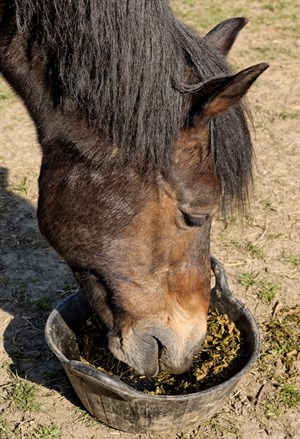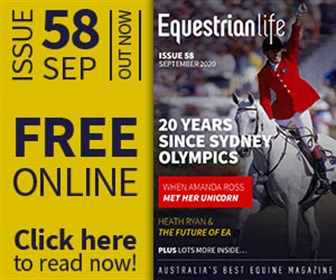|
This article has appeared previously with Equestrian Life. To see what's in our latest issue, click here.

Are you using the right feed for your horse?
When you go into your feed store, what do you consider when choosing your feed? Is the bag a pretty colour? Does it have magical claims of “calm – quite cool” energy sources? Or will it add weight and topline without the fizz? Does it guarantee your horse will win?!
BY DAVID NASH, EQUINE NUTRITIONIST
ARE YOU USING the right feed for your horse? In this article we will discuss what bag labels mean and how to choose the right feed for your horse by evaluating the nutrient levels and feeding rates listed there on the back.
If you remember our previous articles on how to design a feeding program for your horse, we always start from the basics. What is your horse’s weight and condition, its metabolism (is it a good or poor doer)? Do you want to maintain or gain condition and what work rate or breeding/growth stage is your horse at? Then we need to look at what is available to your horse with regards to pasture and hay. From there we can plan what we need to feed your horse to achieve your goals.
The first nutrient that we need to consider, apart from water, is energy and meeting the energy requirements of your horse. If your horse is in good condition with its current feeding rate of pasture or hay and/or supplementary feeding, you can quickly gauge whether you need to feed more or less energy/feed to your horse. The same applies for a horse’s protein requirements.
Once we have established our horses’ comfortable feeding rates we can then look at whether we are providing them with a balanced diet with respect to energy – the type of energy provided, proteins and vitamins and minerals. We often see horses fed 1-2kg of a feed that is designed to be fed at 3-4kg per day. The horse will be meeting its energy and, most likely, protein requirements, but since they are not being fed the supplementary feed as it is designed, the horse may be deficient in micro-minerals such as copper, zinc, manganese etc. Mild imbalances and deficiencies can cause problems with the health and wellbeing of your horse.

Let’s look at the bag
Generally when we see a bag in the store or at a trade display we will see colours and lovely pictures of horses. What we should be concerned with is, firstly, the description. This will generally be under the name of the feed. For example, “High energy feed for working horses”. If this is not what you are looking for, let’s find another descriptor of feed such as “Low energy feed for horses or ponies in maintenance or light work” or “Oats-free muesli concentrate for sport horses”. You will generally see on the bags whether it is a pellet or muesli feed. The choice is yours. You may also see on the bag images of the type of activity that might assist you in your selection process.
Now, let’s turn the bag over. For a nutritionist, this is where I can gather the most information on whether the feed is suitable for my horses. Again we may have a description of what the feed is designed for, and then we will generally see the list of ingredients. The manufacturers should list ingredients from the largest to smallest inclusion levels. If I have a horse that is in light work that does not need large amounts of energy, I may shy away from feeds that have cereal grains as their most prolific ingredients. I would suggest looking for feeds with high inclusion levels of lower energy ingredients, such as chaffs, or super fibres such as beet pulp and soy hulls, and also high fat inclusions such as sunflower seeds and rice bran. Whilst they have moderate energy levels, the way they are digested by the horse will reduce the glycaemic (sugar rush) result to the horse. Next is the most important section of the bag, the feeding directions. I am confident nearly all commercial feeds are formulated to meet a horse’s nutrient requirements and will be matched to feeding rates. For example, a horse in light work may need to be fed 3-4kg of product X per day to meet its nutrient requirements with pasture/hay. If we have been feeding only 2kg per day of product X and the condition of our horse is satisfactory, we are feeding the wrong feed to our horse. We need to either add additional vitamins and mineral supplementation to balance our horses’ diet or select a feed that is designed to be fed at a rate of 2kg per day. A key signal for a lower feeding rate would be that the feed is sold as a concentrate of balancer.

This is the most common mistake I have seen in nearly 20 years as a nutritionist. With improved pastures and different genetics and metabolism of horses, our horses’ caloric requirements from manufactured feeds are not as great. As a result, many feed manufacturers have not altered their formulations and, hence, feeding rates. This has resulted in many of us not meeting our horses’ full nutrient requirements. Another common mistake would be to feed all of our performance horses the same amount, from a 350kg pony to a 650kg Warmblood. Again, with different amounts of hay and pasture, the condition of the horse or pony may be fine but the Warmblood will be deficient in nutrients if the pony’s diet is balanced.
The last few details on the bag are also very significant. The nutrient contents of the bag will show you protein, fat, fibre, macro-minerals such as calcium and phosphorous, and electrolytes, micro-minerals such as copper, zinc and manganese, as well as vitamins. When you compare feed bags you will see that feeds that have high feeding rates will have lower vitamin and mineral levels compared to concentrates. All of these feeds are designed so that if you follow the recommendations your horse will receive approximately the same amount of vitamins and minerals in a daily diet.
Finally, the date of manufacture of the feed: it will either be “date of manufacture” or “best before”. Obviously, fresh is best but feeds have been designed to hold their nutritional integrity for at least six months. Also check the condition of the bag. You want to ensure that it has been stored correctly in a cool, dry place out of direct sunlight. If you can see damp marks on the bag of feed, swap it for one in an acceptable condition.
If all this information confuses you, as there are dozens of feeds on the market for all different types of activity, please talk to a qualified nutritionist who will be able to step you through each individual’s diets and suggest a type of feed that best suits you and your horse.
This article has appeared previously with Equestrian Life.
READ THE LATEST NEWS ARTICLES HERE

|

